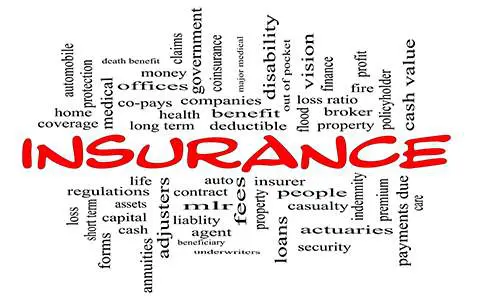
Insurance is complex, so we made this glossary to help readers.Insurance is an agreement between an insurer and insured that provides financial protection in exchange for premium payments, whether indemnity or liability coverage is needed. Policy paperwork also contains important details about each insured party, such as declarations pages.
1. Definitions
Insurance terms can often be defined differently depending on which insurance company defines them; this glossary offers definitions based on popular usage within the industry. Collision insurance—coverage that pays for damage to your car after colliding with another vehicle or object, such as a street sign—is typically required by lenders if you take out an auto loan or lease agreement on it.
Insurable Interest—An insurable interest refers to ownership or legal possession of property that, should it be lost due to loss, would cause financial harm. A person can hold insurable interests in both real and personal assets such as buildings, furniture, vehicles, and other forms of tangible property such as vehicles.
2. Coverage
Insurance provides financial security against unexpected events that might damage households and societies, helping people prepare for them, plan ahead, and lessen the impact. An insurance policy is a legal contract between an insurer and their insured, outlining coverage in detail as well as what losses it covers (called deductibles), exclusions, and the terms of payment.
Most insurance plans are offered through employer-sponsored benefits or can be found on the individual market, while some policies can also be renewed annually and changed during a special enrollment period after certain qualifying life events (QLEs). Insurance may seem complex at first, but understanding its fundamental principles and how best to assess your needs are crucial parts of making smart decisions about coverage.
3. Deductibles
Deductibles are set by policy terms and listed on the Declarations page or front of standard homeowners, condo owners, renters, or auto policies as mandatory payments before coverage begins.
Deductibles are an integral component of the insurance process, as they serve to mitigate financial risk for both insurer and insured alike. Without deductibles in place, individuals could become incentivized to engage in risky behaviors like speeding or leaving their home unprotected, knowing that any potential losses won’t be covered by their insurer.
4. Endorsements
Endorsement is a legal term that describes the act of signing one’s name to transfer specific rights over to someone else, typically to add credibility and prevent unauthorized cashing of checks or bills.
There are different kinds of endorsements, both special and restrictive. A check might be inscribed “Pay to the order of [specified person]” or “For deposit only,” giving the endorser control over how the instrument will be used. Endorsements also commonly appear commercially, with celebrities lending their names for products and services in exchange for financial compensation.
5. Policy Period
Policy Period (PP) is an integral element in health insurance that dictates premiums and coverage features as well as payment dates if on a monthly billing schedule.
Your proof of insurance and/or declaration pages at the start of your policy packet should include information about its policy period. Insurance providers typically set this based on either a calendar or fiscal year when assigning policies to consumers. Health insurance plans often feature annual deductibles that reset at the start of every calendar year; in contrast, private passenger automobile and residential property policies usually follow an annual policy year system.
6. Expiration Date
An insurance policy’s expiration date marks its end. It typically falls on a specific day each year (depending on its type) and is determined by factors including its effective and expiration dates as well as other considerations. Its abbreviation may include EXP or ED.
Insurance terminology may be difficult to decipher, but with some research and assistance from an experienced insurance professional, consumers can make informed decisions about which coverage best meets their needs. To make this task easier, press control+F on a PC and command+F on a Mac to quickly search any unfamiliar terms you encounter during your research process.
7. Policy Language
Policy language refers to a set of terms used to specify policies. It’s intended to be easily understandable by those reading and implementing them; deliberative delineation of responsibilities and expectations with minimal room for alternative interpretation is crucial in creating meaningful policies that work.
Policy complexity must also be recognized; for instance, mandatory language (“shall,” “must”) has different implications than aspirational language (“should,” “endeavor to”). Achieving these goals requires taking into account issues like uncertainty management, measuring performance levels, and controlling unintended consequences, as well as creating language that fits with existing policies and technologies.
8. Limits of Liability
An insurance provider sets limits for each claim it pays out; these could be set per person, per accident, or all at once. Companies also provide different policy limits across coverage types like homeowners and auto policies.
Homeowner policies typically contain two coverage limits—dwelling and personal property—to protect both types of assets, but you may wish to schedule high-priced items like jewelry or firearms with rider policies for full-value coverage. Furthermore, umbrella insurance provides added liability protection—this forms part of an overall portfolio protection strategy.
9. Additional Insureds
As litigious business environments continue, giving your additional insured status could save both you and your company money in the event of a claim. Mortgage lenders, contractors working on your property, or commercial tenants may require that you are listed as an additional insured on their liability coverage policy.
An insurance endorsement, or rider, enables you to gain additional insured status by adding it onto your policy. Its terms impose limitations on how and to whom coverage extends, so it is wise to review them closely prior to adding one. There may also be a nominal fee associated with these endorsements—your business insurance consultant can assist in understanding them better.
